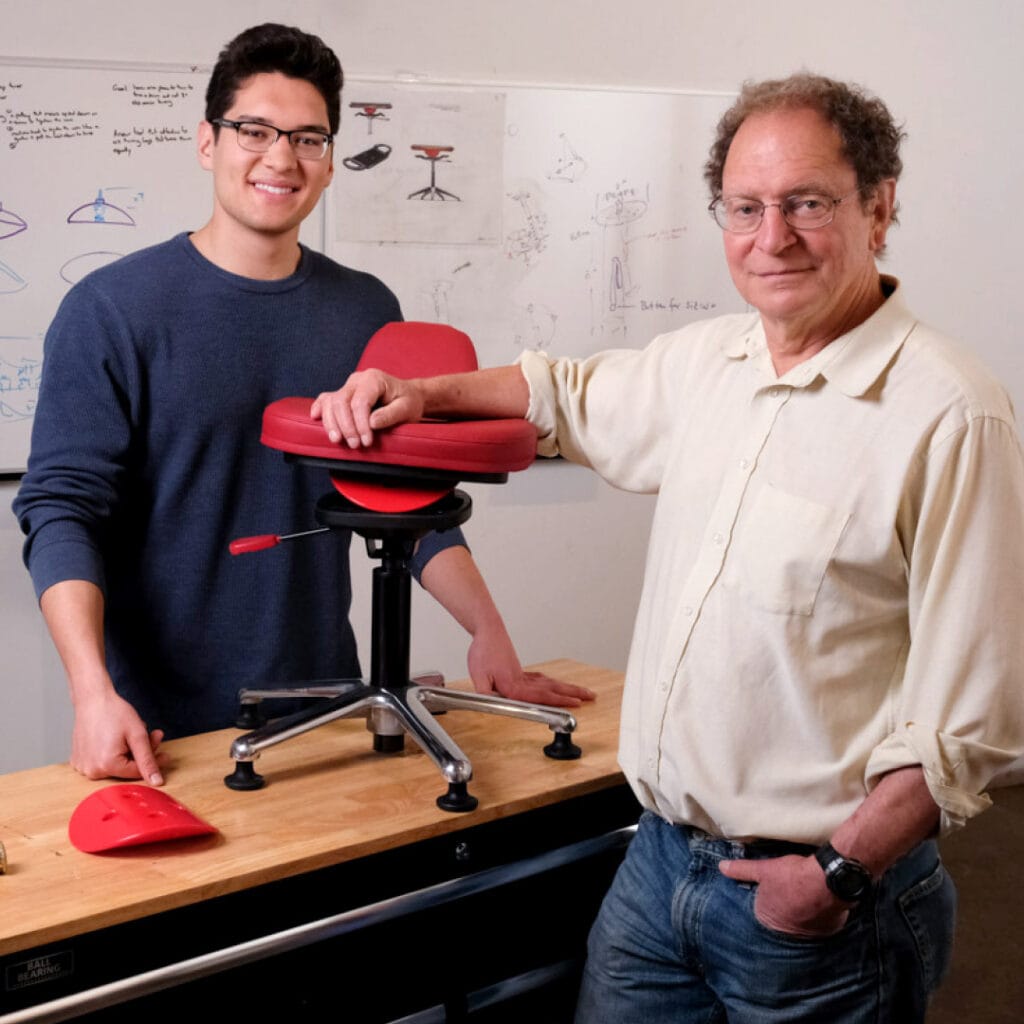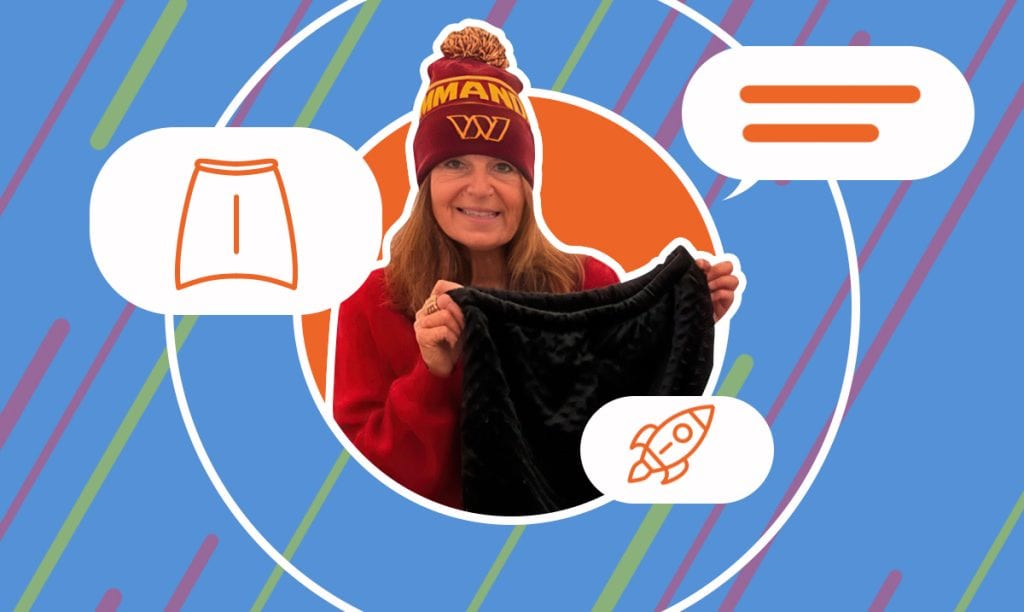If you’ve ever struggled with cold feet in bed or while lounging, CozyFeet might be the perfect solution. Founded during the pandemic by CorinneO& ...
Changing How We Sit with QOR360’s Ergonomic Innovation
Written by: Esther Strauss
Esther is a business strategist with over 20 years of experience as an entrepreneur, executive, educator, and management advisor.
Published on February 13, 2024

In a world where the quest for innovation meets the everyday need for comfort, Dr. Turner Osler, CEO and founder of QOR360, stands as a pioneer. With a passion that turns the ordinary into the extraordinary, he has redefined the way we sit.
In this interview, we delve into the mind of the man who transformed the humble chair into an ergonomic revolution, promising not just a seat but a journey towards better health and productivity. Prepare to be enthralled by the story of QOR360, where science meets design to challenge the status quo, one chair at a time.
Inspiration Behind QOR360’s Innovative Design
SBS – What inspired the creation of QOR360 and its unique chair design?
Dr. Turner – As a physician who’s suffered from a tyranny of conventional chairs for most of his life, my search for a healthier way to sit was quite personal. In 2016, I left the operating room to do research full-time. This required sitting at a desk far more than I was accustomed to. I spent some time checking out various “ergonomic” chairs, but it soon became clear that I’d need to create a better sitting solution to push back against the terrible chairs that Big Chair and ergonomists have sold us for decades. Working with a team of other doctors, designers, and bodywork experts, we created not just a new chair but an entirely new way to sit that worked with the body rather than against it.
Unique Features of QOR360 Chairs
SBS – How does the design of your chairs differ from other ergonomic chairs in the market?
Dr. Turner – Traditional “ergonomic” chairs begin from the proposition that the human body requires external support while sitting. As a surgeon with a deep understanding of anatomy and a student of several movement arts (Aikido, Feldenkrais, Tai Chi), I have a radically contrarian view — the human body is already inclined to exquisite posture, developed over millions of years of evolution. It turns out that your body’s perfect internal ergonomics, its skeleton, is a far better route to perfect posture than “ergonomic” chairs that try to shore up one’s body with external supports: the head rests, foot rests, backrests, armrests, and the coup de grace, lumbar support. These “supports” serve only to distort one’s naturally perfect posture, leading to a host of problems: poor posture, decreased core strength, and back pain. Worse yet, by suppressing natural movements, such chairs reduce metabolic rate, leading to obesity, diabetes, heart disease, and increased all-cause mortality. By making sitting active, we were able to solve these fundamental problems in a single stroke.
Overcoming Challenges in the Ergonomic Furniture Market
SBS – What were the biggest challenges in developing and marketing a new type of ergonomic chair?
Dr. Turner – Because my career was spent in an operating room, I didn’t get out much over the last 30 years. So, really, every step of my entrepreneurial journey was new, exciting, and challenging. I had no experience with designing, patenting, manufacturing, marketing, or shipping a product. But, at least in the design phase, I think my inexperience was actually an asset. Because I had no formal training in design or engineering, I was free to create a new solution to an old problem, unencumbered by previous ideas. Not surprisingly, since my training is in biology, medicine, and surgery, my solution is a novel, almost biological shape that allows a chair to tip slightly in all directions, making sitting active rather than passive. As it happens, this approach is also inexpensive to manufacture and virtually indestructible, both happy consequences of a simple design.
Tailoring Chair Designs for Diverse User Needs
SBS – How do you ensure that your chairs meet the diverse needs of different users?
Dr. Turner – Everyone is different, so it’s impossible to design a chair that will work for everyone. But certain principles apply in every case. So, for example, a chair must be adjustable to a height that will work for both very short and very tall people. Unfortunately, no single gas cylinder will cover the whole range of human sizes, so we sell two versions of our chair: one that covers the range of tall people and a second that works for shorter folks. I don’t think any other “ergonomic” chairs have been willing to do this, but we view it as essential because if a chair doesn’t fit the sitter, it’s a failure.

The Journey of Developing RedRocker™ Technology
SBS – Can you describe the process of developing and patenting the RedRocker™ Technology?
Dr. Turner – Ruthless prototyping. The search for a shape that would tip smoothly in all directions began with a simple hemispheric rocker, which worked, but because it had to be affixed to a base, it had a disconcerting “bump” with every cycle. As we searched through other shapes, we used Styrofoam as a medium that could be rapidly shaped and then hardened by dipping it in fiberglass resin. This allowed us to rapidly prototype many different shapes. As they say in the design world: “fail fast.” Eventually, we hit on our “red rocker” shape, a new geometric solid that is so novel that we patented it.
Effective Marketing Strategies
SBS – What strategies have you found most effective in marketing your chairs, especially in a crowded ergonomic furniture market?
Dr. Turner – Earned media has been our best strategy because the benefits our chairs offer are a complicated story to tell, one that requires much more than a sound bite.
Balancing Affordability and Quality in Chair Manufacturing
SBS – How do you balance product affordability with maintaining high-quality standards?
Dr. Turner – We strive to be the least expensive active chair on the market because, as an epidemiologist, I’m acutely aware that a solution that people cannot afford is no solution at all. A big part of our strategy is to use off-the-shelf parts wherever possible because they are extremely reliable and reduce our production costs. The components that we manufacture are more expensive, in part because the volume is less, but also because we use the best available materials (high-strength steel, reliable locknuts, etc.) to be sure no chair will fail, even for customers who delight in aggressively rocking.
Leveraging Customer Feedback for Product Improvement
SBS – What role has customer feedback played in the evolution of your product line?
Dr. Turner – Customer feedback was essential to creating our chairs. Looking back on the process, although I didn’t realize it at the time, our customers were a sort of informal focus group. It worked like this: we would develop a chair and first try it out on ourselves and our friends and family. Once we had the bugs worked out, we would put the design up for sale on our website where customers could easily and inexpensively buy it. We would then email every customer, asking what they liked and, crucially, what they didn’t like about our chairs. And, of course, we were happy to take back any chair that a customer decided wasn’t for them, giving a full refund and paying return postage.
This process really clarified for us what features customers valued and what didn’t matter so much to them. This approach allowed us to rapidly understand that careful, expensive woodworking wasn’t nearly as important to customers as that our chairs were affordable, an insight that led us to deemphasize some very creative designs executed in plywood (our ButtOn Chair is a good example) and instead concentrate on designs that used as many off-the-shelf office chair components (aluminum star base, gas cylinder height mechanism) as possible. So, for our Ariel chairs, we manufacture only the crucial parts that make our chair unique (the seat and rocker) and purchase the other parts for our chair from manufacturers that make millions of these components every year. We are thus able to “borrow” the economy of scale for these parts while still having the freedom to offer entirely new and uniquely healthful chairs.
Boosting E-Commerce Sales and Engagement Tactics
SBS – As an e-commerce business, what tactics have you employed to increase online sales and customer engagement?
Dr. Turner – E-commerce is essential to our business model because it allows us to leave retailers (and their markup) out of the process and share the savings with our customers. But the downside is we have to find our customers for ourselves. We have done this largely by engaging with earned media to help them tell the story of “sitting disease” and its health consequences to their readers. Our chairs naturally come into the story at some point, and readers can then easily find us on the web if they agree that passive sitting is a problem.
Earned media is powerful, and so it’s important to be ready for its impact. A couple of years ago, The Wall Street Journal published a piece about our company, and within two weeks, we sold about a thousand chairs, more than we’d sold in the preceding year. This stretched our supply chain to the limit, but we were able to fill all the orders within a month despite the pandemic shutting down our warehouse.
Another example of the power of earned media: NPR’s program Here and Now did a 5-minute story on our company, and within minutes, our website went from one visitor every few minutes to one visitor every second. This crashed our website, but fortunately, our team was able to get back up and running within minutes. Note to self: surplus capacity is essential when the whole web is your market.
Earned media used to be just newspapers where other people talk about you, but these days, it includes many hybrid forms, such as TED Talks, where carefully vetted speakers can talk about themselves. I did a TEDx Talk on the problems caused by passive sitting, which got 40K views, and even though I never mentioned our company in my talk, people managed to find our website pretty easily.
TikTok gets a lot of buzz, but for us, it was a mixed bag: we put up a short TikTok about how to sit better on a standard chair, which got almost a million views, but curiously, it didn’t generate many sales. Seemingly, it’s not only about views.
Finally, we’ve also found word of mouth to be a big help; fully 20% of our customers tell us that they heard about our chairs from a friend. I think word of mouth works so well because friends tend to be similar, so folks willing to take the plunge into active sitting on our chairs often have similarly inclined friends.
Managing Logistics and Supply Chain
SBS – How do you handle logistics and supply chain management, especially during periods of high demand?
Dr. Turner – We do most of our manufacturing and all of our assembly and shipping locally in Vermont, so we can visit in person with our suppliers and stay on top of things even as conditions change. We now have some components manufactured in Taiwan, and this requires that we keep a substantial stock of these parts on hand in our Vermont warehouse.
Adapting to Remote Work and Home Office Trends
SBS – In what ways has your company adapted to the changing landscape of remote work and home offices?
Dr. Turner – Remote work has given a real boost to our sales because people needed to upgrade their work from home offices. More than that, folks working from home make their own decisions about what sort of sitting solution works best for them. We’ve had trouble convincing ergonomists at big companies that our active chairs are a good option because we break so many aspects of the “ergonomic dogma.” But when people are able to decide for themselves, well, many find that active sitting is just what they’ve been looking for.
Future Vision and Expansion Plans
SBS – What future plans do you have for QOR360 in terms of new products or business expansion?
Dr. Turner – We’ve discovered that getting people to sit in an entirely new way is a big ask; most people are pretty sure they know everything there is to know about chairs. But we’re hopeful that kids will prove to be more open-minded. Kids instinctively understand that movement is healthy and try hard to move while sitting, squirming, twisting, and basically trying to stay in constant motion. So, we’d like to introduce active sitting in schools, but their constrained budgets require a radically simplified design that could be cheaply produced. We call our answer to this challenge the BetterBall chair.
Entrepreneurial Advice for Innovating in Traditional Markets
SBS – Lastly, what advice would you offer to entrepreneurs looking to innovate in traditional industries, such as office furniture?
Dr. Turner – I’d say, “Play to your strengths,”
Because I had no particular strengths, when we chose to go up against “Big Chair” in the adult office furniture realm with an entirely new design, we assumed we had to do it all ourselves: invent, manufacture, and finally sell chairs.
For those who want to take on the whole project as we did, I’d say, “Just do it.” But do it in an iterative way. Create a design, make some, and get them into the hands of consumers to see what they have to say, and then fix what consumers tell you needs to change. If you wait until you have a perfect product, well, it just won’t happen. In the words of one of my entrepreneurial heroes, Reid Hoffman: “If you are not embarrassed by the first version of your product, you’ve launched too late.” I’m plenty embarrassed by our initial offering, but fortunately, there aren’t too many of them out there, and against expectations, the people who have them love them.
On the other hand, I have a designer friend who also wants to change what chairs are, but he’s taken a different route. He created a design that he’s currently shopping around to chair manufacturing companies, hoping to find a company that will take over his design. So far, no luck. I can’t be sure if this is just business as usual or if the established chair manufacturers (“Big Chair”) are making too much money to want to rock the boat.
This isn’t to say that licensing a design can’t work; we’re currently hammering out a royalty agreement for our BetterBall design with a company that sells furniture to schools. But I think the school market may be more receptive to new designs; the ergonomic industry has too big an investment in its current design to want to change anything.
Comments
Leave a Reply
Subscribe to Our Newsletter
and gain insider access to cutting-edge business insights and trends.
Featured Resources

How CozyFeet Foot Warmers Help with Cold Feet Issues
Published on February 27, 2025
Read Now

How Plaza Japan Found a Niche in Japanese Anime and Hobby Products
Published on August 26, 2024
Jun Ibaraki, the visionary behind Plaza Japan, transformed his passion for Japanese culture into a thriving e-commerce business that bringsauthentic ...
Read Now

How Natalie Created a Thriving Maternity Clothing Brand
Published on July 29, 2024
In this interview, we dive into the inspiring journey of Natalie Pitts, the CEO and founder of Go MamaMaternity. Discover how Natalie identified ...
Read Now
Thank you very much for this high quality interview. I have had contact with Turner Osler and his team and they sent me an Ariel chair to try out. Great people and great product.